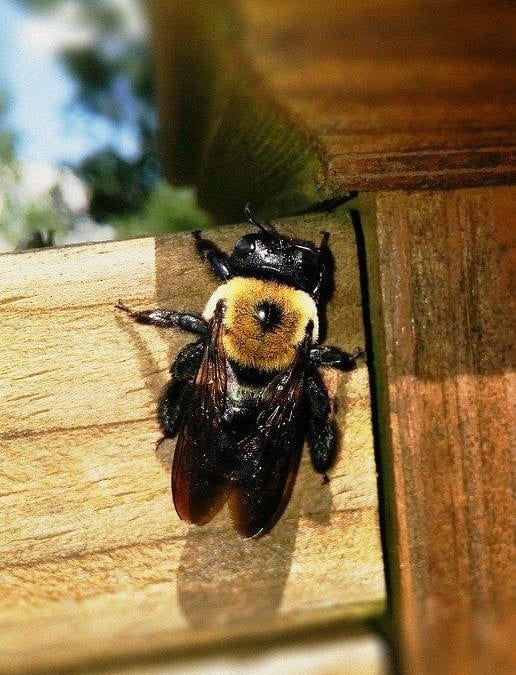Spring in Maine is gorgeous, with all its fresh blooms, warmer weather, and spectacular bursts of colors. But, unfortunately, spring is followed by swarms of carpenter bees whose only purpose is to destroy outdoor structures as well as the wood inside your home.
Carpenter bees are quite like bumblebees, except that they nest differently and also have different destructive properties. Carpenter bees are a common occurrence in Maine, and many times, people living in this part of the United States are taken aback by the sudden appearance of these pests crawling out of their wooden structures.
These big fuzzy bees are quite destructive and even dangerous in terms of how badly they can sting a person. If you’ve lately noticed a large number of carpenter bees hovering around in your backyard, then the chances are that there is a fully grown nest somewhere back there.
A carpenter bee infestation needs your immediate attention, and it’s essential that you take effective measures to get rid of them at the earliest.
Facts about Carpenter Bees
Before you get to elimination strategies for carpenter bees in your yard, it is a good idea to learn a few facts about them and know what exactly you are dealing with.
- There are more than 500 species of carpenter bees that are distributed worldwide.
- They have the ability to create tunnels as long as 10 feet that they build with the help of their strong jaws while vibrating through the wooden structures.
- Carpenter Bees are known to damage and stain furniture, buildings, wooden panels of doors, fences, and windows.
- These bees aren’t active year-round, and they tend to hibernate during the winter season.
- Carpenter bees get their name from their unique nesting behavior, which is characterized by burrowing into hard materials like bamboo and deadwood.
- Carpenter bees typically emerge in early spring and tend to hibernate through the winter in their nests.
- Carpenter bees are often mistaken for bumblebees, but one of the many distinguishing factors between the two is that the former has a shiny black tail section.
- Male carpenter bees are known to be quite aggressive based on how they defend their nest against predators, but in actuality, that’s just a pretense.
- Carpenter bees don’t thrive in huge colonies or hives like honey bees, for instance. Female bees lay eggs in individual nests, and their male counterparts don’t exactly live long enough to need a nest.
- If you catch or squeeze a carpenter bee, it will sting. These bees are able to sting over and over again since their stingers are not barbed.
- Carpenter bees have a bare and glossy abdomen with a furry thorax.
- Female carpenter bees have black heads, whereas the male bees have white spots on their black heads.
How to Get Rid of Carpenter Bees
Given how destructive carpenter bees are, it is vital that you take effective measures to get rid of them from your yard as well as your home.
Here are some of the most useful things you can do to keep these fuzzy bees at bay.
Use a Natural Repellant
Most pests are allergic to natural repellants like oils, and so are carpenter bees. These bees particularly hate the smell of citrus oil, making it just the right repellant for them.
Simply spray citrus oil in all carpenter bee hotspots in your yard as well as newly drilled holes to prevent them from creating their nests. Another thing you can do is wipe down all those surfaces or areas with citrus oil that are becoming an attraction for the bees. Doing this will also keep them from coming back.
DIY Pest Control Solution
In case of a carpenter bee infestation in your home or backyard, a simple yet highly effective solution is to make a DIY pest control solution.
Take a jar and fill it with a few cloves of garlic along with your regular cooking oil. Let the mixture sit for a few days, and then add some quantity of acidic white vinegar. Mix the solution and spray it near carpenter tunnels and all over your backyard.
In case that doesn’t work, sprinkle a good amount of garlic powder directly into the carpenter bee holes to sway them away.
Sound-Causing Devices
It is interesting to note that carpenter bees don’t like noise or vibration near their nesting sites. So, a simple solution here is to place sound-causing devices such as wind chimes or any other similar wind-noise devices around their nesting sites to stop them from building their nests.
Seal Old Carpenter Bee Holes
Carpenter bees have a habit of coming back to the same holes again and again, so an effective measure to keep them away for good is to seal off all the holes permanently. This significantly reduces the chances of them returning to your home or yard.
Seal Exposed Wood
These pesky bees are always looking for exposed wooden openings to drill holes; therefore, you must seal all exposed wood inside and around your home since these are a common candidate for a carpenter bee infestation.
Call a Professional Pest Control Service
Undoubtedly, the safest and fastest way to get rid of carpenter bees from your home and backyard is to call a professional pest control or bee removal service.
Ants Plus is one such service in Maine that aims to protect the things that are most important to you. We are fully equipped with the right tools, equipment, and measures to make your home pest-free and also prevent any kind of serious infestation in the future.
Contact us today and learn all about our pest control services.
